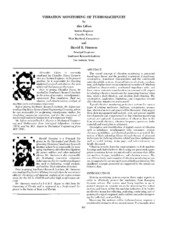| dc.description.abstract | The overall concept of vibration monitoring is presented based upon theory and the practical constraints of machinery construction, transducer characteristics and the cost/benefit ratio of available systems. General features of velocity, acceleration, and displacement measurements are considered. Machine malfunction characteristics, mechanical impedance ratio, and force versus restraints consideration are assessed with respect to selecting vibration transducers for measuring housing vibration, relative shaft vibration, and absolute shaft vibration. The construction, application, limitations, and comparison of available vibration transducers is discussed. Typical vibration monitoring protection systems for various types of rotating machinery (turbines, compressors, pumps, fans, electrical motors and gears) will be discussed. Data acquisition, data management and analysis, cost, and general capabilities of periodic and computerized on-line vibration monitoring systems are analyzed. A presentation of vibration data in the form of overall vibration, vibration frequency spectrum, bode, waterfall and trend plots is addressed. Description and identification of typical sources of vibration such as unbalance, misalignment, rubs, resonance, subsynchronous instabilities, and electrical problems is provided. Detection of blade related problems through the use of advanced techniques for defining vibration related machine malfunctions such as modal testing, strain gage, and radio telemetry are briefly discussed. Vibration severity limits for measurements on both machine housings and shaft relative to the housing are presented; appropriate correction factors are introduced to accommodate different machine designs, installations, and vibration sources. The use of these limits, and examples of vibration monitoring successes, is supported by reviewing the actual field case histories. The significant concepts presented are supported by the actual case histories data. | en |


